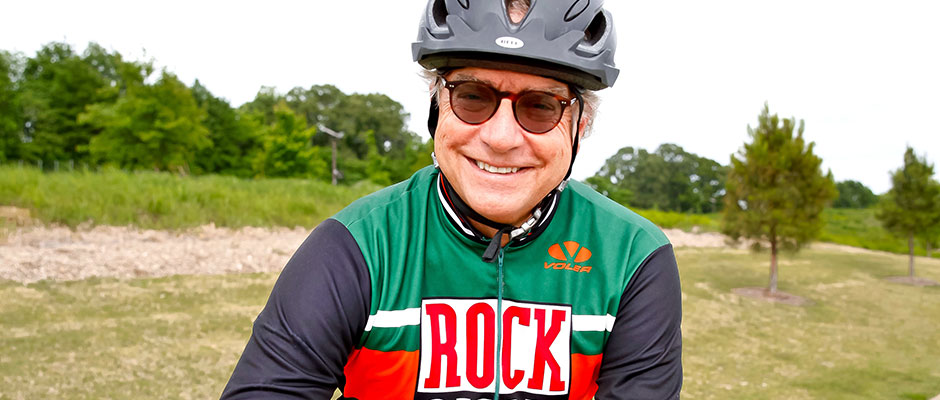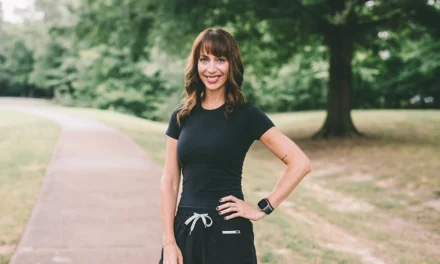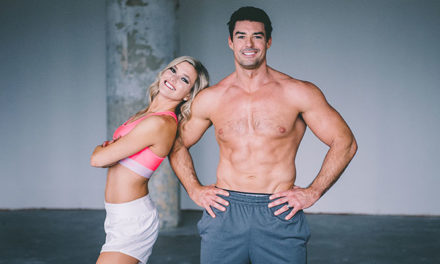As a neurologist and the medical director of Mays & Schnapp Neurospine and Pain, Moacir Schnapp, M.D., 69, knows all about the benefits of regular exercise. Yet, he, like so many of us, used to fall short of meeting the recommended amount of weekly physical activity for adults. That all changed once he wed his beloved in 1979. “I got active after I married my sweet wife who exercises every day. She used to be a dancer and a physician,” says Dr. Moacir.
Incorporating Movement Every Day
Thanks to her, he was introduced to Pilates and new types of cardio exercises. He has since developed his own workout routine and is now a fan of paddleboarding on the lake and biking along the trails at Shelby Farms. “After 12 hours indoors, I like to have the sun in my face for at least half an hour,” he says. Back in the day, you could even catch him windsurfing, but as Moacir jokes, “I’m getting too old for that.”
To get his daily dose of movement, he follows the same advice he gives his patients. “We tell people, the best camera is the one you’ve got in your pocket. Exercise is the same thing. It’s whatever is readily available. If you’ve got a bike in the car, use it. If you’re close to the gym, use it,” he says. Not only does his gear have a permanent home in his vehicle, Moacir also relies on his memberships at Germantown Athletic Club and the Jewish Community Center for a change of scenery. “I tend to alternate cardiovascular with weight training,” he says. Swimming and home workouts with his Total Gym®, which he highly recommends, are in the mix too.
Exercise and Aging
In terms of the relationship between exercise, pain and stiffness, and aging, it is almost guaranteed that the latter will go hand in hand with pain and stiffness says Moacir. “The aging process is inevitable. All your joints are going to fall apart. The trick is not to not age. The trick is to enjoy your life the best you can until you die,” he says. Along with that sentiment, he likes to share a quote by author Nora Ephron, “The secret of life is to make your money and your health last as long as you do.” Moacir says, “Exercise will do both because economists have calculated that every day you go to the gym, you save $50 in after-tax money. That’s money you’re not going to spend on doctors.”
He explains that regular movement can greatly improve stiffness. It also relieves pain, as can the treatments he and his team provide such as physical therapy, medication, and interventional pain management techniques.
Moacir advises that if you do have pain, like chronic low back pain, neck pain, or osteoarthritis in your joints, and want to exercise that you do it under supervision. He suggests working with an expert like himself to develop a program that suits your needs and can be adjusted if necessary. If you don’t have pain but start to notice it, you should also seek professional guidance.
Getting Started
The doctor also has wise words for those who have never made physical activity a regular part of their life but wish to. Unlike most physicians who recommend walking as a perfectly fine way to exercise and a good place to start, Moacir says that doesn’t fly with him. “I tell my patients they can walk after they exercise. Walking is relaxing, but it doesn’t burn enough calories and doesn’t build enough muscle, but for most people, it’s pleasant. The unpleasant part is what you have to start with,” he says.
He suggests building up your exercise routine carefully. “I use the example of the baseball players who go to Florida for spring training, so they don’t get injured. You start slowly, methodically, and every day you incorporate a little bit more,” Moacir says. That can look like just a few minutes a day of cardio and strength training with free weights, resistance bands or machines and eventually working your way to 45 minutes. Then, you can go out and walk he says, “As a prize for having done a good job exercising.”
The Added Benefits
Besides staving off future health problems and making aging more enjoyable, Moacir stresses the additional upsides exercise has. He says that along with gaining a sense of accomplishment, a chemical called brain-derived neurotrophic factor (BDNF) is also released, which Moacir describes as the equivalent to “putting fertilizer on roses in your garden.” He says, “You can get this from antidepressants or you can get it from exercise. … It helps with anxiety. It helps with panic attacks. It helps with depression. It relieves OCD. So, there’s nothing bad about exercise, provided you’re doing it properly.”
So, whether you’ve been active for years or are just jumping in, this is your sign to keep going and keep moving, for your health’s sake.
By Alexandra McCray
Photo by Kim Thomas







